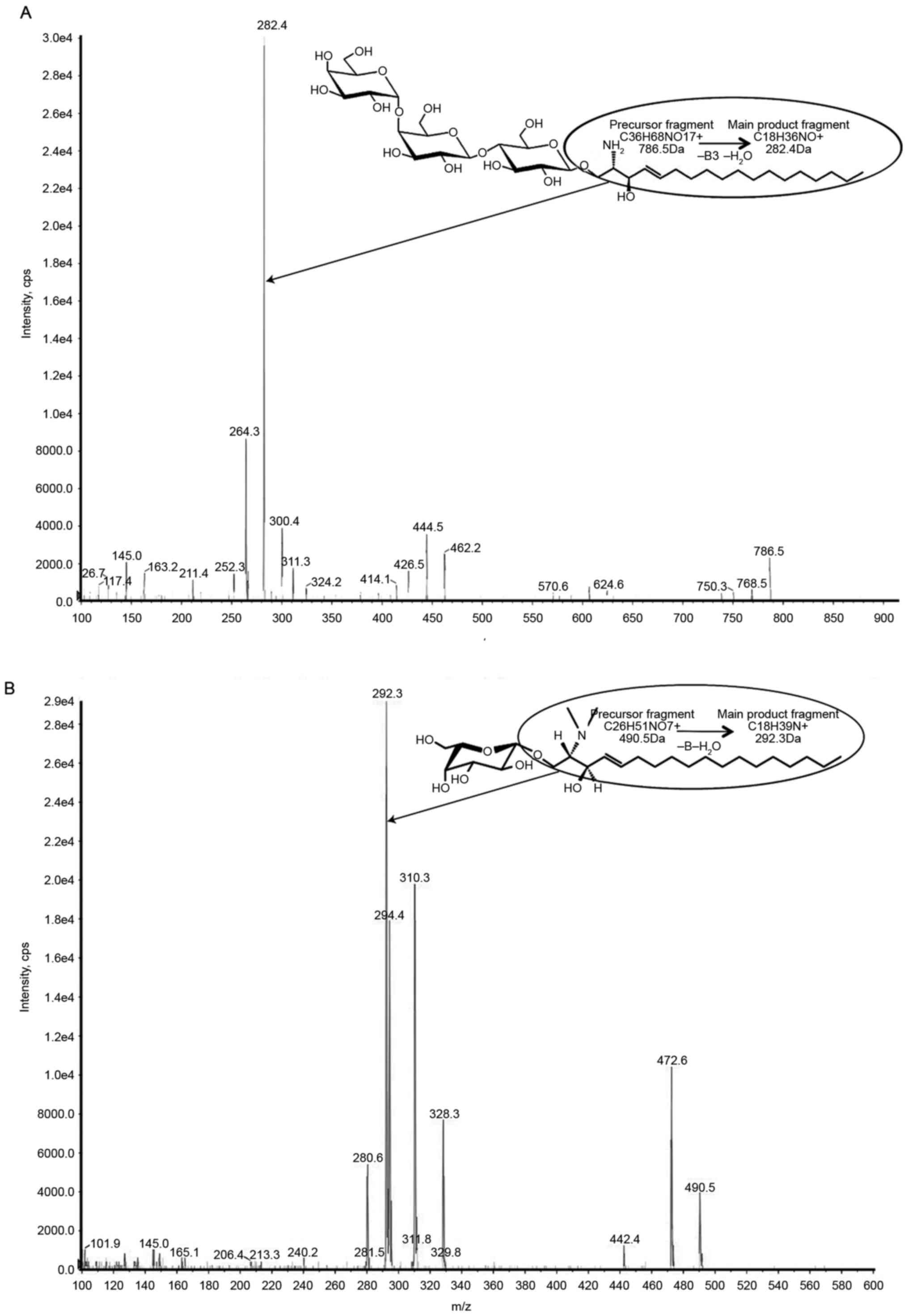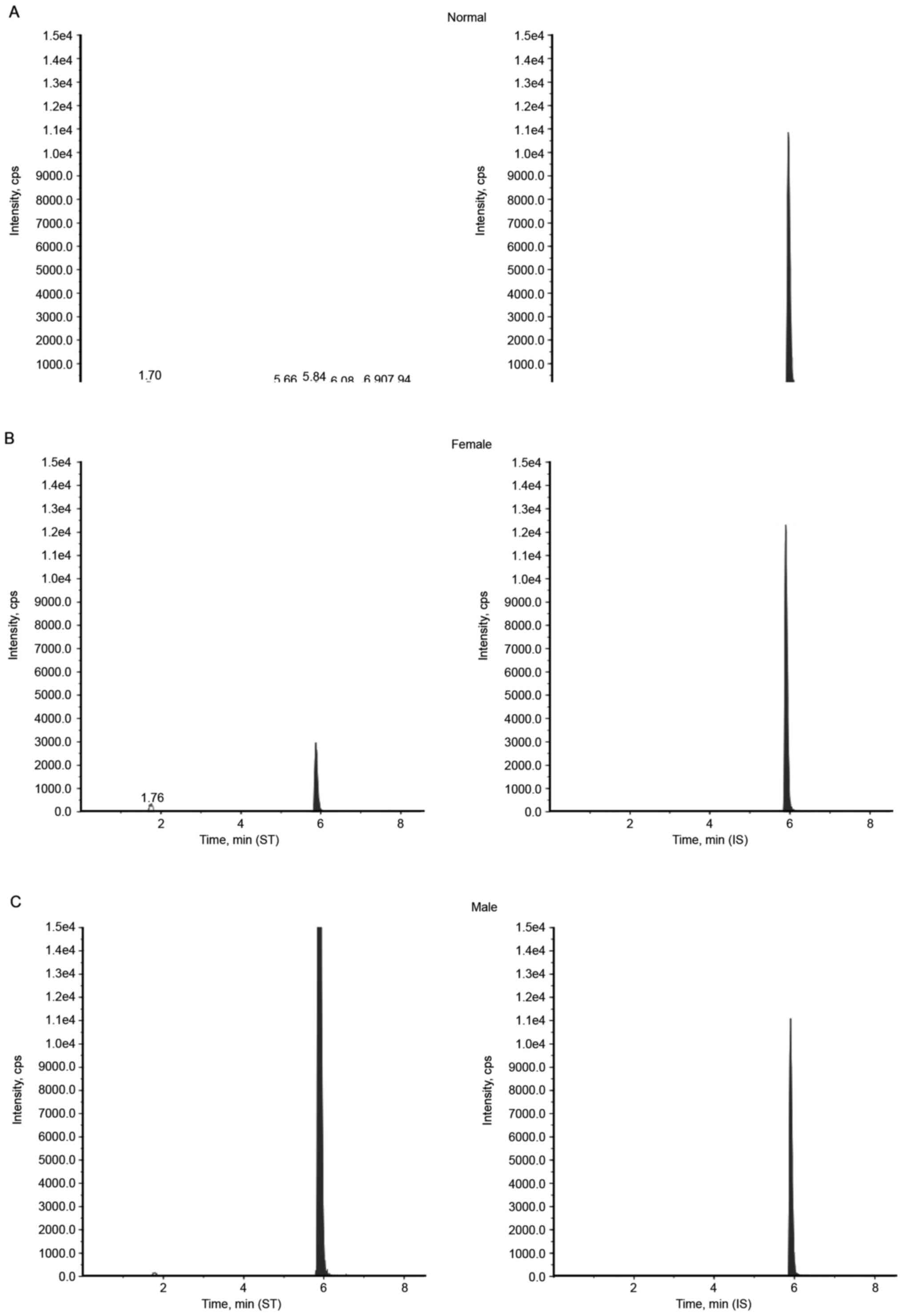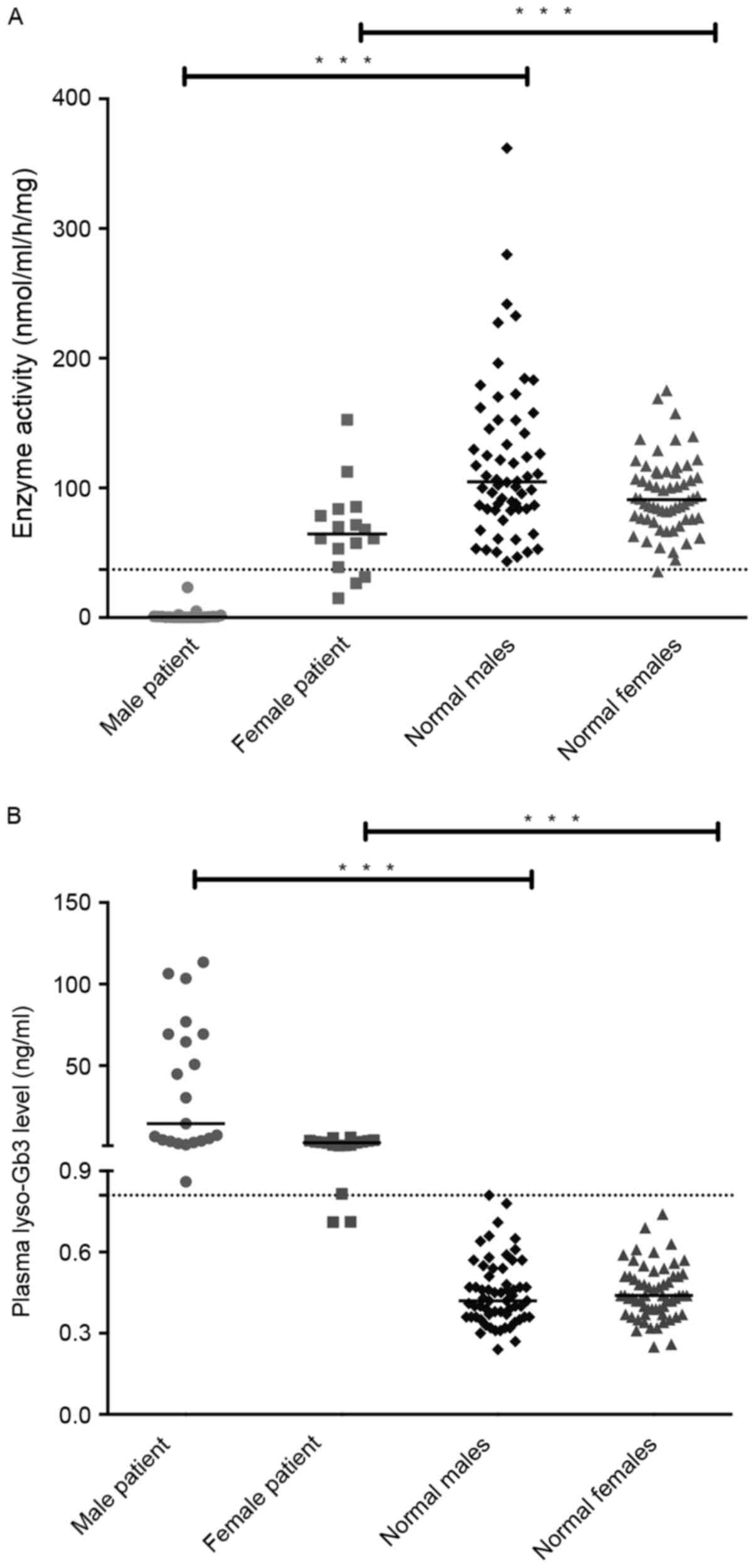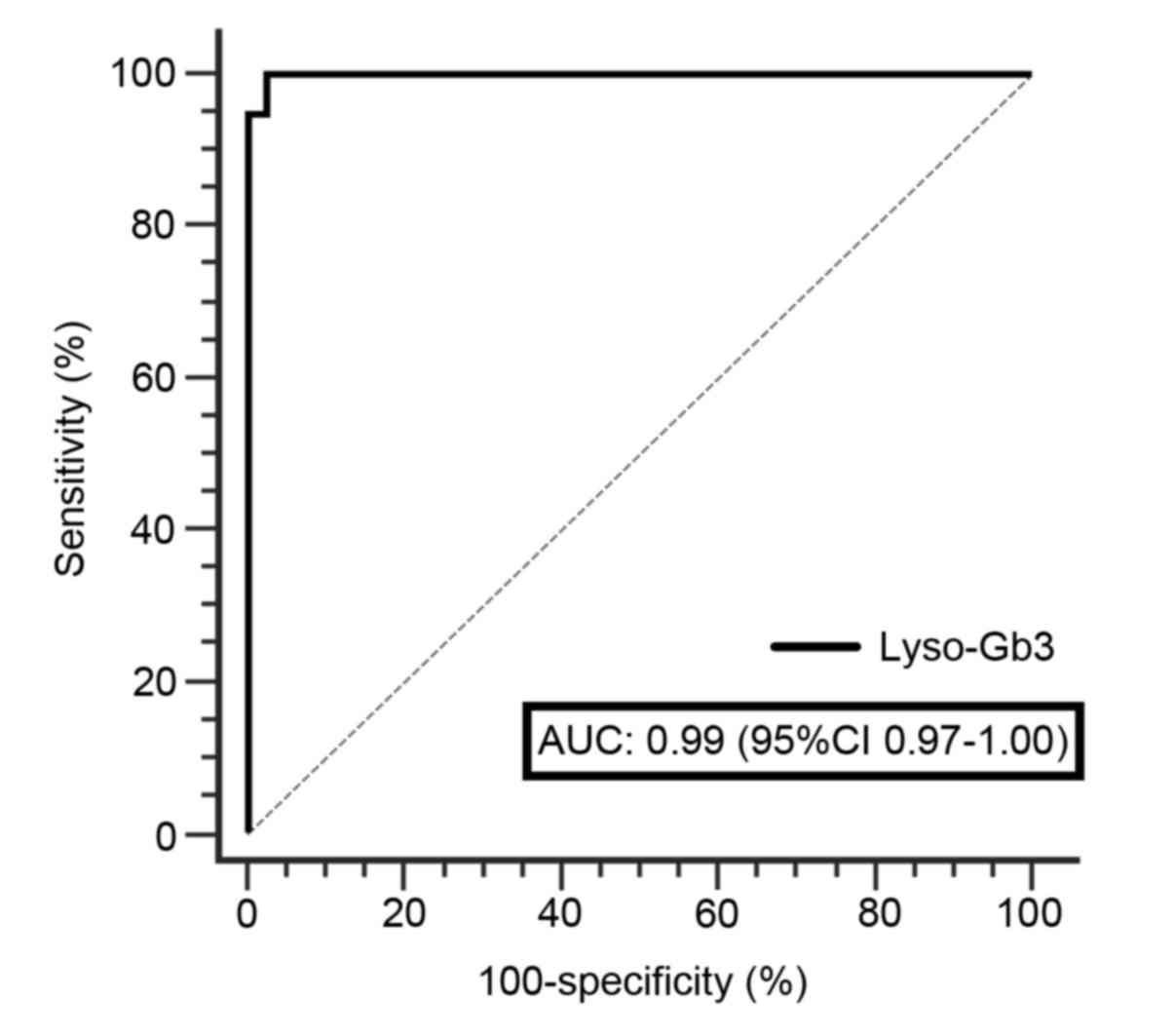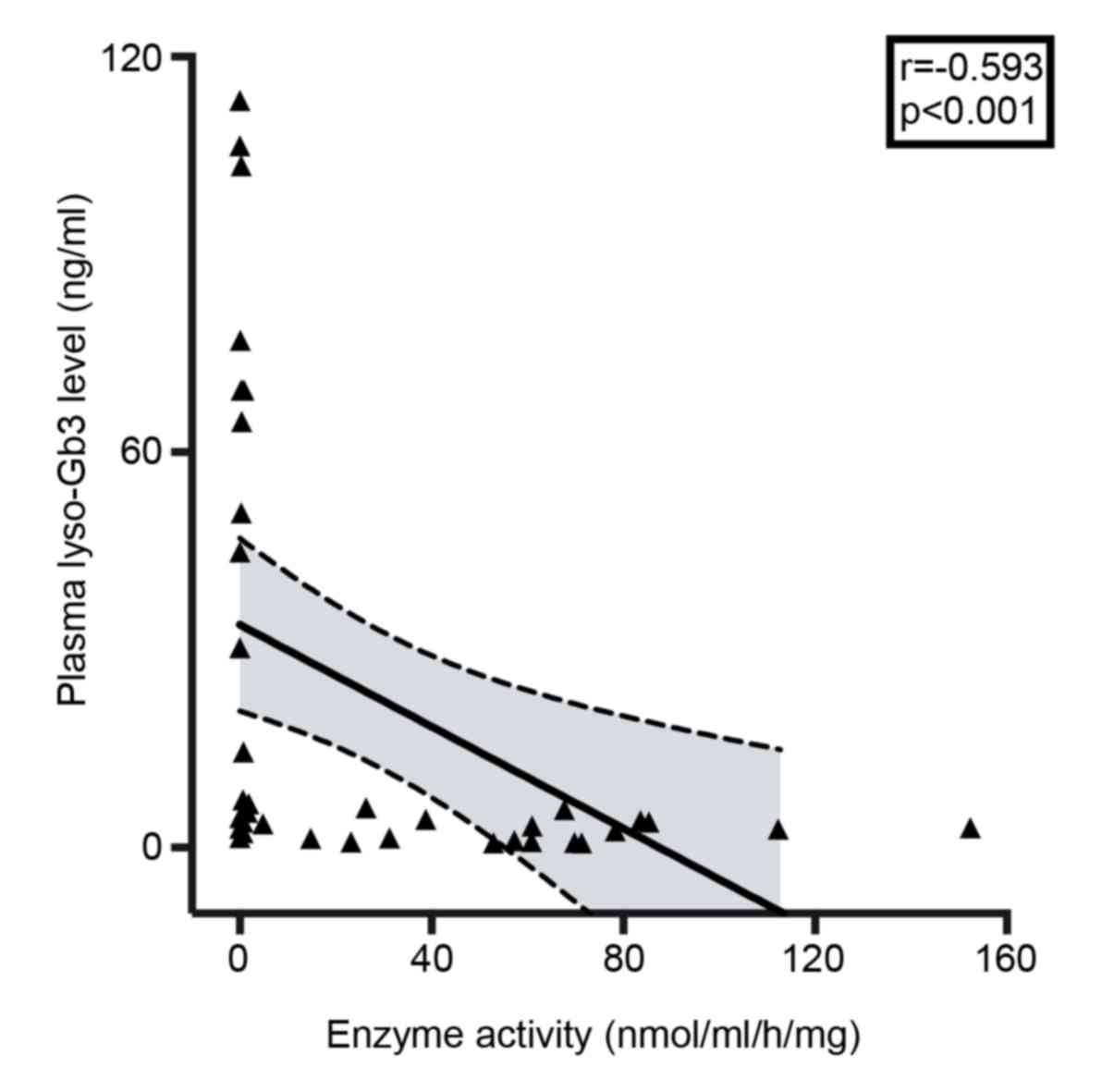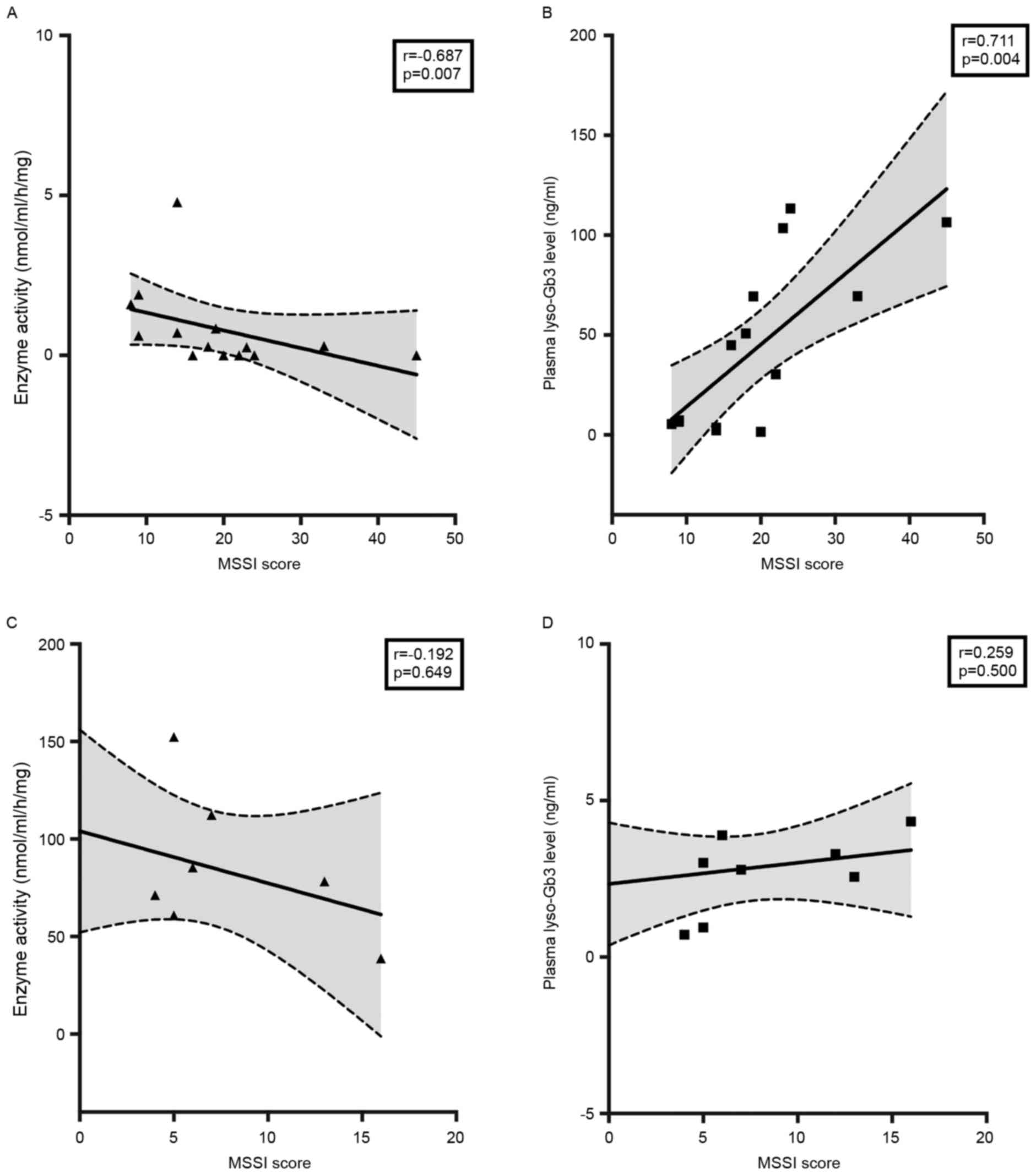|
1
|
Germain DP: Fabry disease. Orphanet J Rare
Dis. 5:302010. View Article : Google Scholar : PubMed/NCBI
|
|
2
|
Askari H, Kaneski CR, Semino-Mora C, Desai
P, Ang A, Kleiner DE, Perlee LT, Quezado M, Spollen LE, Wustman BA
and Schiffmann R: Cellular and tissue localization of
globotriaosylceramide in Fabry disease. Virchows Arch. 451:823–834.
2007. View Article : Google Scholar : PubMed/NCBI
|
|
3
|
Desnick RJ, Brady R, Barranger J, Collins
AJ, Germain DP, Goldman M, Grabowski G, Packman S and Wilcox WR:
Fabry disease, an under-recognized multisystemic disorder: Expert
recommendations for diagnosis, management, and enzyme replacement
therapy. Ann Intern Med. 138:338–346. 2003. View Article : Google Scholar : PubMed/NCBI
|
|
4
|
Elleder M, Bradová V, Smíd F, Budĕsínský
M, Harzer K, Kustermann-Kuhn B, Ledvinová J, Bĕlohlávek, Král V and
Dorazilová V: Cardiocyte storage and hypertrophy as a sole
manifestation of Fabry's disease. Report on a case simulating
hypertrophic non-obstructive cardiomyopathy. Virchows Arch A Pathol
Anat Histopathol. 417:449–455. 1990. View Article : Google Scholar : PubMed/NCBI
|
|
5
|
Nakao S, Kodama C, Takenaka T, Tanaka A,
Yasumoto Y, Yoshida A, Kanzaki T, Enriquez AL, Eng CM, Tanaka H, et
al: Fabry disease: Detection of undiagnosed hemodialysis patients
and identification of a ‘renal variant’ phenotype. Kidney Int.
64:801–807. 2003. View Article : Google Scholar : PubMed/NCBI
|
|
6
|
Brady RO, Gal AE, Bradley RM, Martensson
E, Warshaw AL and Laster L: Enzymatic defect in Fabry's disease.
Ceramidetrihexosidase deficiency. N Engl J Med. 276:1163–1167.
1967. View Article : Google Scholar : PubMed/NCBI
|
|
7
|
Linthorst GE, Vedder AC, Aerts JM and
Hollak CE: Screening for Fabry disease using whole blood spots
fails to identify one-third of female carriers. Clin Chim Acta.
353:201–203. 2005. View Article : Google Scholar : PubMed/NCBI
|
|
8
|
Kitagawa T, Ishige N, Suzuki K, Owada M,
Ohashi T, Kobayashi M, Eto Y, Tanaka A, Mills K, Winchester B and
Keutzer J: Non-invasive screening method for Fabry disease by
measuring globotriaosylceramide in whole urine samples using tandem
mass spectrometry. Mol Genet Metab. 85:196–202. 2005. View Article : Google Scholar : PubMed/NCBI
|
|
9
|
Whitfield PD, Calvin J, Hogg S, O'Driscoll
E, Halsall D, Burling K, Maguire G, Wright N, Cox TM, Meikle PJ and
Deegan PB: Monitoring enzyme replacement therapy in Fabry
disease-role of urine globotriaosylceramide. J Inherit Metab Dis.
28:21–33. 2005. View Article : Google Scholar : PubMed/NCBI
|
|
10
|
Rozenfeld PA, De Francesco NP, Borrajo GJ,
Ceci R and Fossati CA: An easy and sensitive method for
determination of globotriaosylceramide (Gb3) from urinary sediment:
Utility for Fabry disease diagnosis and treatment monitoring. Clin
Chim Acta. 403:194–197. 2009. View Article : Google Scholar : PubMed/NCBI
|
|
11
|
Young E, Mills K, Morris P, Vellodi A, Lee
P, Waldek S and Winchester B: Is globotriaosylceramide a useful
biomarker in Fabry disease? Acta Paediatr Suppl. 94:51–54;
discussion 37–58. 2005. View Article : Google Scholar : PubMed/NCBI
|
|
12
|
Blaydon D, Hill J and Winchester B: Fabry
disease: 20 novel GLA mutations in 35 families. Hum Mutat.
18:4592001. View Article : Google Scholar : PubMed/NCBI
|
|
13
|
Schäfer E, Baron K, Widmer U, Deegan P,
Neumann HP, Sunder-Plassmann G, Johansson JO, Whybra C, Ries M,
Pastores GM, et al: Thirty-four novel mutations of the GLA gene in
121 patients with Fabry disease. Hum Mutat. 25:4122005. View Article : Google Scholar
|
|
14
|
van der Tol L, Smid BE, Poorthuis BJ,
Biegstraaten M, Deprez RH, Linthorst GE and Hollak CE: A systematic
review on screening for Fabry disease: Prevalence of individuals
with genetic variants of unknown significance. J Med Genet. 51:1–9.
2014. View Article : Google Scholar : PubMed/NCBI
|
|
15
|
Fazekas F, Enzinger C, Schmidt R, Grittner
U, Giese AK, Hennerici MG, Huber R, Jungehulsing GJ, Kaps M,
Kessler C, et al: Brain magnetic resonance imaging findings fail to
suspect Fabry disease in young patients with an acute
cerebrovascular event. Stroke. 46:1548–1553. 2015. View Article : Google Scholar : PubMed/NCBI
|
|
16
|
van der Tol L, Cassiman D, Houge G,
Janssen MC, Lachmann RH, Linthorst GE, Ramaswami U, Sommer C,
Tøndel C, West ML, et al: Uncertain diagnosis of fabry disease in
patients with neuropathic pain, angiokeratoma or cornea
verticillata: Consensus on the approach to diagnosis and follow-up.
JIMD Rep. 17:83–90. 2014. View Article : Google Scholar : PubMed/NCBI
|
|
17
|
van der Tol L, Svarstad E, Ortiz A, Tøndel
C, Oliveira JP, Vogt L, Waldek S, Hughes DA, Lachmann RH, Terryn W,
et al: Chronic kidney disease and an uncertain diagnosis of Fabry
disease: Approach to a correct diagnosis. Mol Genet Metab.
114:242–247. 2015. View Article : Google Scholar : PubMed/NCBI
|
|
18
|
Smid BE, van der Tol L, Cecchi F, Elliott
PM, Hughes DA, Linthorst GE, Timmermans J, Weidemann F, West ML,
Biegstraaten M, et al: Uncertain diagnosis of Fabry disease:
Consensus recommendation on diagnosis in adults with left
ventricular hypertrophy and genetic variants of unknown
significance. Int J Cardiol. 177:400–408. 2014. View Article : Google Scholar : PubMed/NCBI
|
|
19
|
Aerts JM, Groener JE, Kuiper S,
Donker-Koopman WE, Strijland A, Ottenhoff R, van Roomen C, Mirzaian
M, Wijburg FA, Linthorst GE, et al: Elevated
globotriaosylsphingosine is a hallmark of Fabry disease. Proc Natl
Acad Sci USA. 105:pp. 2812–2817. 2008; View Article : Google Scholar : PubMed/NCBI
|
|
20
|
Togawa T, Kodama T, Suzuki T, Sugawara K,
Tsukimura T, Ohashi T, Ishige N, Suzuki K, Kitagawa T and Sakuraba
H: Plasma globotriaosylsphingosine as a biomarker of Fabry disease.
Mol Genet Metab. 100:257–261. 2010. View Article : Google Scholar : PubMed/NCBI
|
|
21
|
Rombach SM, Dekker N, Bouwman MG,
Linthorst GE, Zwinderman AH, Wijburg FA, Kuiper S, Vd Bergh Weerman
MA, Groener JE, Poorthuis BJ, et al: Plasma
globotriaosylsphingosine: Diagnostic value and relation to clinical
manifestations of Fabry disease. Biochim Biophys Acta.
1802:741–748. 2010. View Article : Google Scholar : PubMed/NCBI
|
|
22
|
Krüger R, Tholey A, Jakoby T, Vogelsberger
R, Mönnikes R, Rossmann H, Beck M and Lackner KJ: Quantification of
the Fabry marker lysoGb3 in human plasma by tandem mass
spectrometry. J Chromatogr B Analyt Technol Biomed Life Sci
883–884. 1–135. 2012.
|
|
23
|
Gold H, Mirzaian M, Dekker N, Joao Ferraz
M, Lugtenburg J, Codée JD, van der Marel GA, Overkleeft HS,
Linthorst GE, Groener JE, et al: Quantification of
globotriaosylsphingosine in plasma and urine of fabry patients by
stable isotope ultraperformance liquid chromatography-tandem mass
spectrometry. Clin Chem. 59:547–556. 2013. View Article : Google Scholar : PubMed/NCBI
|
|
24
|
Boutin M, Gagnon R, Lavoie P and
Auray-Blais C: LC-MS/MS analysis of plasma lyso-Gb3 in Fabry
disease. Clin Chim Acta. 414:273–280. 2012. View Article : Google Scholar : PubMed/NCBI
|
|
25
|
Lukas J, Giese AK, Markoff A, Grittner U,
Kolodny E, Mascher H, Lackner KJ, Meyer W, Wree P, Saviouk V and
Rolfs A: Functional characterisation of alpha-galactosidase a
mutations as a basis for a new classification system in fabry
disease. PLoS Genet. 9:e10036322013. View Article : Google Scholar : PubMed/NCBI
|
|
26
|
Lavoie P, Boutin M and Auray-Blais C:
Multiplex analysis of novel urinary lyso-Gb3-related biomarkers for
Fabry disease by tandem mass spectrometry. Anal Chem. 85:1743–1752.
2013. View Article : Google Scholar : PubMed/NCBI
|
|
27
|
Boutin M and Auray-Blais C: Multiplex
tandem mass spectrometry analysis of novel plasma
lyso-Gb3-related analogues in Fabry disease. Anal Chem.
86:3476–3483. 2014. View Article : Google Scholar : PubMed/NCBI
|
|
28
|
Auray-Blais C, Boutin M, Gagnon R, Dupont
FO, Lavoie P and Clarke JT: Urinary
globotriaosylsphingosine-related biomarkers for Fabry disease
targeted by metabolomics. Anal Chem. 84:2745–2753. 2012. View Article : Google Scholar : PubMed/NCBI
|
|
29
|
Dupont FO, Gagnon R, Boutin M and
Auray-Blais C: A metabolomic study reveals novel plasma lyso-Gb3
analogs as Fabry disease biomarkers. Curr Med Chem. 20:280–288.
2013. View Article : Google Scholar : PubMed/NCBI
|
|
30
|
Sessa A, Toson A, Nebuloni M, Pallotti F,
Giordano F, Battini G, Maglio A, Meroni M, Calconi G, Bertolone G
and Gatti P: Renal ultrastructural findings in Anderson-Fabry
disease. J Nephrol. 15:109–112. 2002.PubMed/NCBI
|
|
31
|
Desnick RJ, Allen KY, Desnick SJ, Raman
MK, Bernlohr RW and Krivit W: Fabry's disease: Enzymatic diagnosis
of hemizygotes and heterozygotes. Alpha-galactosidase activities in
plasma, serum, urine, and leukocytes. J Lab Clin Med. 81:157–171.
1973.PubMed/NCBI
|
|
32
|
Pan X, Ouyang Y, Wang Z, Ren H, Shen P,
Wang W, Xu Y, Ni L, Yu X, Chen X, et al: Genotype: A crucial but
not unique factor affecting the clinical phenotypes in fabry
disease. PLoS One. 11:e01613302016. View Article : Google Scholar : PubMed/NCBI
|
|
33
|
Levey AS, Stevens LA, Schmid CH, Zhang YL,
Castro AF III, Feldman HI, Kusek JW, Eggers P, Van Lente F, Greene
T, et al: A new equation to estimate glomerular filtration rate.
Ann Intern Med. 150:604–612. 2009. View Article : Google Scholar : PubMed/NCBI
|
|
34
|
Schwartz GJ, Haycock GB, Edelmann CM Jr
and Spitzer A: A simple estimate of glomerular filtration rate in
children derived from body length and plasma creatinine.
Pediatrics. 58:259–263. 1976.PubMed/NCBI
|
|
35
|
Whybra C, Kampmann C, Krummenauer F, Ries
M, Mengel E, Miebach E, Baehner F, Kim K, Bajbouj M, Schwarting A,
et al: The mainz severity score index: A new instrument for
quantifying the Anderson-Fabry disease phenotype, and the response
of patients to enzyme replacement therapy. Clin Genet. 65:299–307.
2004. View Article : Google Scholar : PubMed/NCBI
|
|
36
|
Bligh EG and Dyer WJ: A rapid method of
total lipid extraction and purification. Can J Biochem Physiol.
37:911–917. 1959. View
Article : Google Scholar : PubMed/NCBI
|
|
37
|
NCCLS, . Evaluation of Precision
Performance of Quantitative Measurement Methods; Approved
Guideline-Second Edition. NCCLS document EP5-A2. ISBN:
1-56238-542-9NCCLS; Wayne, PA: 2004
|
|
38
|
NCCLS, . Evaluation of the Linearity of
Quantitative Measurement Procedures: A Statistical Approach;
Approved Guideline. NCCLS document EP6-A. ISBN: 1-56238-498-8NCCLS;
Wayne, PA: 2003
|
|
39
|
Jamboti J and Forrest CH: Fabry disease;
early diagnosis improves prognosis but diagnosis is often delayed.
J Nephropathol. 6:130–133. 2017. View Article : Google Scholar : PubMed/NCBI
|
|
40
|
Kes VB, Cesarik M, Zavoreo I, Butković SS,
Kes P, Bašić-Jukić N, Rački S, Jakić M, Delić-Brkljačić D, Jukić Z,
et al: Guidelines for diagnosis, therapy and follow up of
Anderson-Fabry disease. Acta Med Croatica. 68:223–232.
2014.PubMed/NCBI
|
|
41
|
Smid BE, van der Tol L, Biegstraaten M,
Linthorst GE, Hollak CE and Poorthuis BJ: Plasma
globotriaosylsphingosine in relation to phenotypes of Fabry
disease. J Med Genet. 52:262–268. 2015. View Article : Google Scholar : PubMed/NCBI
|















